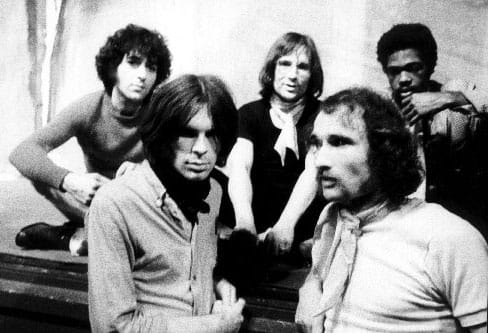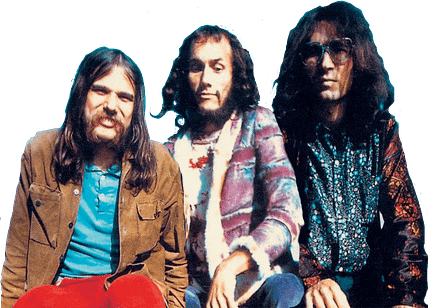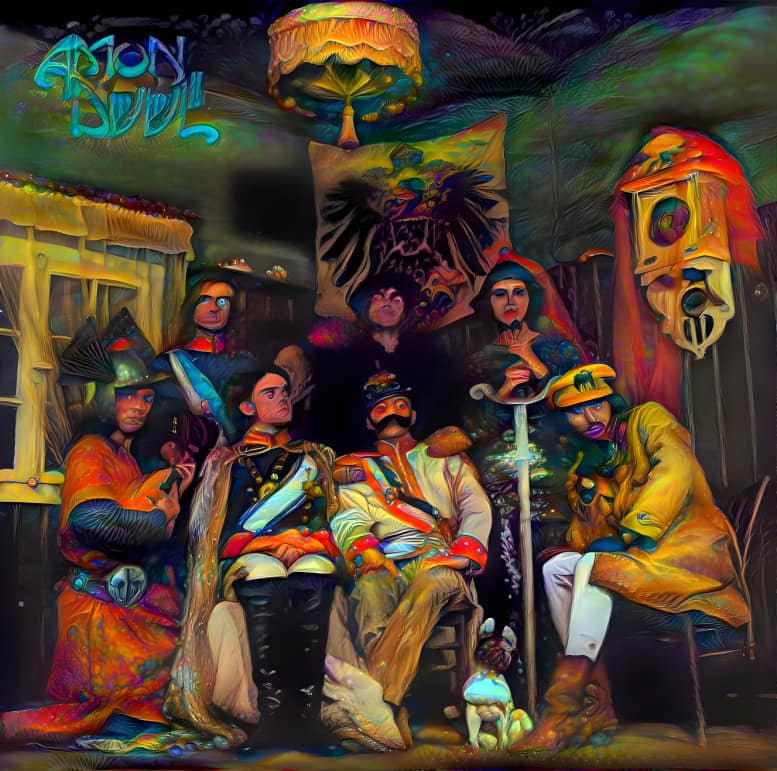In the Introductory post (‘What is Krautrock‘?) I tried to look at some of the forces at play in the development of German music from the 1970s. By nature it´ll be a quite subjective list of the best Krautrock albums. The artists I’ll be talking about are, CAN, Guru Guru, Amon Düül II, Kraftwerk, Tangerine Dream and Ash Ra Tempel. This whole series of articles are in chronological order. I’ll try and provide some context for each band.
CAN-‘You Doo Right’ from ‘Monster Movie’ (Köln July 1969)

CAN hit the ground running. The first track of their debut album ‘Father Cannot Yell’ came together spontaneously, the first time they played together. It’s the take you can hear on the record. They’d come together by complete chance. Holger Czukay, bass player and private tutor enlisted one of his students on guitar. That student, Michael Karoli had opened Czukay’s ears to what was going on in rock, playing him the Beatles’ ‘I am the Walrus’.
Czukay and keyboard player Irmin Schmidt had studied together under Karlheinz Stockhausen. That the biggest band in the world were using Stockhausen’s arsenal (found sounds, short-wave radios) planted a seed.
As drummer they enlisted Jaki Liebezeit who was by now developing a new, cyclical form of drumming. One influenced by drummers like Elvin Jones and Max Roach. Supple and disciplined, precise yet expressive.
Liebezeit had his ‘Road to Damascus’ moment after being told by an audience member ‘You have to play Monotonous‘.
Monotonous is a pejorative word. Trance-inducing would maybe be a better description.
Endless Rotating Rhythms
‘You Doo Right’ is a showcase for Liebezeit’s endless rotating rhythms. The rest of the band follow his lead. American singer Malcolm Mooney particularly uses the repetition of rhythmic phrases, parts of speech. It results in an abstraction of voice and rhythm. ‘A drumbeat, 21 hours a day’ wasn’t far away from their reality.
Mooney wasn’t in the best mental place during his time in CAN. He was in Germany to avoid being drafted into the US Army. He felt paranoid, and isolated. Black American men were not common in Germany at the time. There’s no suggestion that any members of the band were at all discriminatory. No doubt though he will have felt the disapproving gaze of the older generation with his hippy garb and sheer difference.
Mooney thankfully got to feeling a lot better after his time in CAN but he left behind some compelling performances. Raspy and wrecked, you can hear the desperation in his voice. It’s compelling. My own personal favourite of his recordings with the band is ‘The Thief’. It was described by a friend of mine as ‘The Sound of Drowning’.
‘Yoo Doo Right’ is dominated by Mooney and Liebezeit. By all accounts it was edited down from a 6 hour jam session. This kind of editing would become a hallmark of CAN records.
Guru Guru-‘Stone In’ from ‘UFO’ (Heidelberg 1970)
Guru Guru were a heavy, sludgy proposition at this point. The Wah and Fuzz workouts come off like proto-stoner rock at times. At others the mix is overwhelmed by electronic effects. All the way through Neumeier’s drums ride the dynamics of the piece. The whole effect is not too far away from the jazz metal of king Crimson, but much looser and freer.

They were politically progressive too, involved in ‘the struggle’ in it’s various forms. The anarchy of their music was just another representation of these beliefs. Some members lived in communes. They read political texts and poems on stage. That’s not to say they were dry and preachy. LSD was part of their political philosophy. Their shows were freak-outs. They managed to capture a lot of this madness on record.
Amon Düül II-‘Archangels Thunderbird’ from ‘Yeti’ (München, 1970)
Cut from a similar anarcho-revolutionary cloth were Amon Düül. They’d grown out of a commune themselves. The II in their name is to distinguish them from that original commune. The more musically able members formed this band.
They studiously avoided listening to ‘commercial’ music of the time. The likes of Eric Clapton were verboten so as not to absorb cliched influences and licks.
Like all of that generation of musicians they were struggling to break free and create new forms. That meant long jam sessions, overdubbing, a few psychedelics along the way to shake the cobwebs out.
By the time of ‘Yeti’ their second album they were tight and intent of creating a new form of German rock music. There’s a little of Frank Zappa’s influence in the wacky song titles and a lot of the anything goes approach of Psychedelia.

‘Yeti’ was a double album and was split between a disc of relatively conventional songs and a second of longer, extended jams.
‘Archangels Thunderbird’ from the first disc is probably their most famous song. The brainchild of vocalist Renate Knaup, it slaps. Knaup based it on a childhood hymn and the band supplied a dynamic arrangement. At the junction of ‘Louie Louie’ and the Jefferson Airplane. However, it’s the vocal performance that makes this song.
Krautrock was dominated by men even though feminism was definitely a part of the counter-culture. Renate Knaup was a very rare example of a women being an integral part of one of the bands.
Her voice here is strident, proud. There’s a similarity to what Sandy Denny was doing with Fairport Convention at the time, melding traditional melodies with the sound of a rock band. There’s a similarity in tone too to me. Maybe my ears deceive me but I can also hear the roots of a lot of Punk vocals in her delivery. The keening delivery of John Lydon, the intensity of Poly Styrene.
It was covered by The Breeders a few years ago.
Kraftwerk-‘Ruckzuck’ from S/T (Düsseldorf 1970)
The Kraftwerk Gesamtkunstwerk really only got off the ground in 1974 with Autobahn. Their life project was the creation of a vision of the fusion between man and machine. It’s one we’ll be returning to later in this series.
V2 Schneider
Before that though they were an experimental music ensemble. As avant-garde as any released on a major label. Ralf Hutter and Florian Schneider met at the Academy of Arts in Remscheid, near Düsseldorf, studying piano and flute respectively and improvisation together. They discovered a shared love for music like The Velvet Underground, The Stooges and The Doors. The two decided to form a band, one that would use electronics to make sounds as intense as those bands were.

Hutter came from a musical family, studied piano from an early age. Schneider also had an artistic background. His family going back generations were architects, sculptors and artists. His own father was very successful. This meant that Florian Schneider had start up capital.
This money enabled them to build up an arsenal of instruments, acoustic and electronic. To experiment with plugging them together. They engaged with other musicians and made 3 albums, working with producer Conny Plank.
These albums are edited out of the official Kraftwerk story. They don’t have a united theme. They have no concept. They are however important documents. And in ‘Ruckzuck’ there is a genuine banger.
Sons of the Silent Age
But I can completely understand why they’ve chosen to exclude all of this, it’s inconsistent and occasionally embarrassingly naïf. By way of proof here’s a clickbait titled video of Ralf Hutter playing a Keytar with a Mullet. Kraftwerk really did invent the 1980s, acid basslines and all. The most bizarre detail for me is that this kind of thing was getting airplay on German Television.
For a while Kraftwerk enlisted the help of Michael Rother and Klaus Dinger. These two young men went on to form NEU! and make some very important records with Conny Plank.

Here they are doing ‘Ruckzuck’ together for German Radio. A quick note here is that as the obsessively fastidious Kraftwerk Organisation do not recognise these recordings they’re not on Spotify, this is a bootleg. At the very least they haven’t sought to wipe them off the face of the earth.
We’ll be hearing more from NEU! in due course. And of course we´ll be returning to Kraftwerk.
Tangerine Dream-‘Ultima Thule Pt. 1’ from ‘Alpha Centauri’ (Berlin 1971)
In many ways Krautrock was a late flowering of psychedelia. Pop culture moved so quick at the cusp of the 70s that artists in Britain and the US had on the whole stopped experimenting and ‘got back to their roots’, preferably in the countryside.
The musicians living in Berlin didn’t have the choice of spending time in nature. Their city was surrounded by East Germany. If anywhere in West Germany was a bubble it was Berlin.

Tangerine Dream had evolved through the experimental arts labs of West Berlin. They wore their psychedelic influences proudly, their name being taken from a mishearing of the lyrics to ‘Lucy in the Sky with Diamonds’.
Their first album was tape collage and primitive electronics. By the time they recorded their second they included a lot more ‘standard’ instrumentation. Namely this was keyboards. They started off with organs and Mellotron. In the years to come the name Tangerine Dream would become synonymous with synthesisers.
With Alpha Centauri they centred on a ‘Kosmische’ sound. Frequently floating and beat-less. Mellotron and flute drift together in a pool of reverb. It could at times be a far out instrumental for a sci-fi movie.
The track ‘Ultima Thule’ itself was a 7″ issued around the same time. It’s on the re-issues. The first part is very much in the vein of classic psychedelia. It uses the ‘Andalucian Cadence‘, A descending chord sequence with a regal feel, all this with a pretty tight sounding garage band. Here’s the second, more ambient sounding part, wobbly mellotrons to the fore.
Ash Ra Tempel-‘Amboss’ from ‘Ash Ra Tempel’ (Berlin 1971)
Berlin was a bubble, musicians, freaks, stuck and worked together in a patchwork of projects. Klaus Schulze had played drums on the first Tangerine Dream album and soon after he got to working with Manuel Göttsching. Göttsching was a young guitarist who loved the Who and had really fallen for the Proto-Punk American band Blue Cheer (named after a batch of really good acid Blue Cheer were so loud they apparently killed a Pidgeon that got too close to their speaker stack.)

As an instrumental three piece Ash Ra Tempel recorded a debut album consisting of 2 side-long pieces of music. This is the first. At times it’s like a cross between live Jimi Hendrix, the Who, or indeed the Groundhogs ‘Live at Leeds’ (R.I.P. Tony McPhee.) In short amped up rock.
This is rock music informed by free-jazz. It’s not so much about melodic content as a primal howl.
Göttsching was plugging his guitar into effects boxes, wah-wah, fuzz, echo. It’s the last of those that would go on to be his trademark. Later Ash Ra Tempel albums would be considerably cleaner sounding. None would be as raw and live sounding as this. It’s the sound of a band playing hard in a room.
And that about wraps it up for this post. If you’ve made it this far then well done, thanks for reading and I’m looking forward to having you back for the next part.
Bonus Beats
Here’s the totally un-Krautrock but completely funky Niagara. Jazz drummer Klaus Weiss formed the project and got into overdubbing huge percussion tracks with vaguely sleazy sounding session players on hand. It’s a highly prized record among collectors of beats and breaks. The cover is pretty sleazy too but, it was a different time.
A Shameless Plug
Here’s a track I did a while back where I managed to rip off Krautrock AND the Stooges.
Until next time stay safe out there.